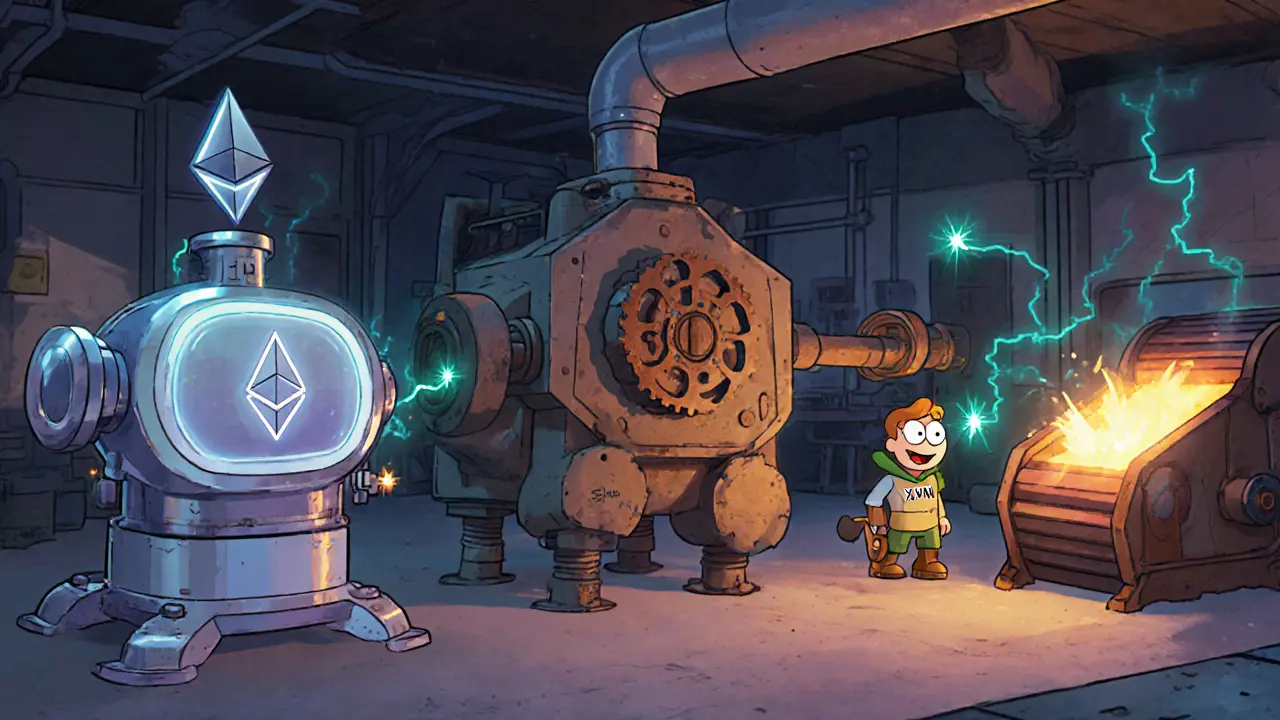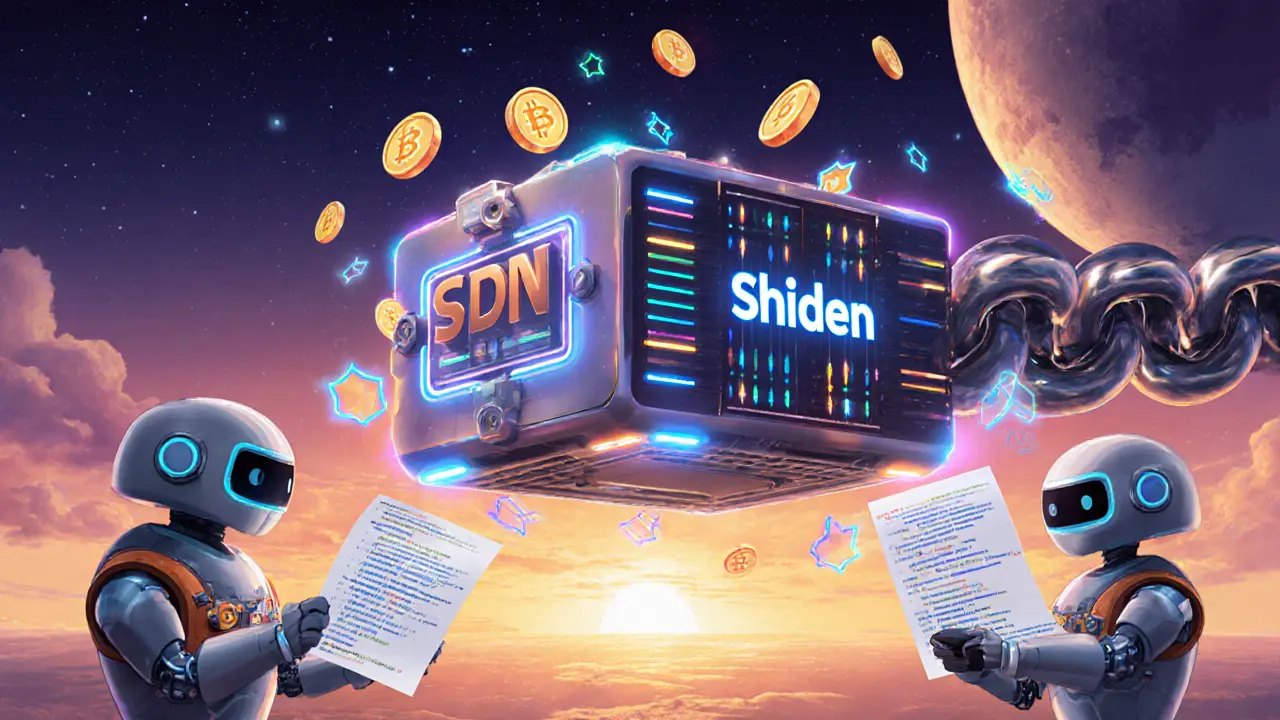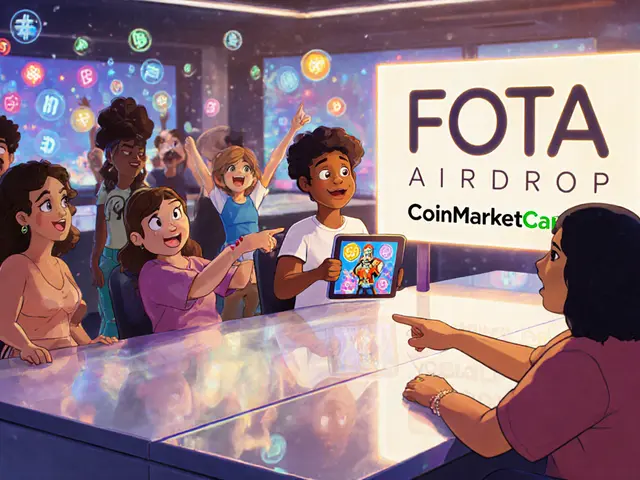Kusama EVM Platform Comparison Tool
Select features that matter most to you to see which platform is best for your project.
Key Takeaways
- Shiden Network is a multi‑chain smart‑contract layer built on the Kusama network.
- Its native token, SDN, powers transaction fees, staking, and validator rewards.
- Supports EVM, WebAssembly, and Layer‑2 solutions through the Astar XVM runtime.
- Serves as a testing ground (Shibuya) for projects before they launch on Polkadot.
- Liquidity and exchange coverage are limited, which adds price volatility.
What Is Shiden Network?
Shiden Network is a multi‑chain decentralized application (DApp) layer that operates as a parachain on the Kusama Network. Launched on June 25, 2021 by Sota Watanabe and the Plasm team, Shiden was created to fill the smart‑contract gap in Kusama, which originally only offered generic relay‑chain security.
The network’s purpose is two‑fold: provide developers with a fast, interoperable environment for deploying DApps, and act as a "canary" for Polkadot projects-meaning new features can be trialed on Shiden before moving to Polkadot’s main parachain ecosystem.
Technical Architecture
Shiden combines three execution environments:
- Ethereum Virtual Machine (EVM) compatibility (enabled September2021) lets Solidity contracts run unchanged.
- WebAssembly (Wasm) support opens the door for Rust‑based contracts and high‑performance workloads.
- Astar XVM, an extended virtual machine, merges EVM and Wasm calls into a single runtime, allowing cross‑environment interaction.
Transaction processing reaches roughly 1,000 TPS with a finality time of around six seconds, according to Kraken’s 2024 analysis. The shared security model of Kusama’s relay chain underpins Shiden, meaning validators stake both KSM and SDN to secure the parachain.

SDN Token Economics
SDN is the native utility token. Total supply caps at 82million, with about 63million in circulation (76.7% of total) as of October2025. SDN serves several roles:
- Payment of transaction fees (average fee≈$0.03898 per token).
- Staking for validator selection and network consensus.
- Reward distribution for block authors and parachain slot auctions.
- Commission for cross‑chain message execution via XVM.
Market data on October142025 shows a price of $0.0415 and a 24‑hour trading volume of roughly $47,400, indicating modest liquidity across five major exchanges.
Developer Ecosystem & Shibuya Testnet
Shiden’s developer experience revolves around two environments:
- The mainnet, where live DApps serve end users.
- The Shibuya testnet, an identical parachain that connects to its own relay chain. Developers can deploy contracts, run integration tests, and catch bugs before moving to mainnet. A 2024 developer survey reported that 82% of participants faced fewer mainnet issues after testing on Shibuya.
Typical onboarding for an experienced Solidity developer takes 15‑20hours, while Rust newcomers need additional time to master Wasm tooling. Community support is active on Discord (≈12.5k members) and through regular workshops hosted by the core team.
How Shiden Stacks Up Against Competitors
| Feature | Shiden Network | Moonbeam | Acala |
|---|---|---|---|
| EVM Compatibility | Full (via XVM) | Full (native) | Partial (focus on DeFi‑specific tooling) |
| WebAssembly Support | Yes | No | Yes |
| Layer‑2 Integration | Supported | Limited | Limited |
| 24‑h Volume (USD) | ≈$47k | ≈$28M | ≈$5M |
| Active DApps | ≈1,200 | ≈3,500 | ≈1,800 |
Shiden’s unique selling point is its multi‑environment runtime, allowing developers to mix Solidity and Rust contracts in the same DApp. Moonbeam excels at pure Ethereum parity, while Acala focuses on DeFi primitives like stablecoins and lending.

Risks, Criticisms, and Market Perception
Analysts highlight three main concerns:
- Liquidity constraints: Limited exchange listings (only five major platforms) cause slippage spikes-up to 8% in turbulent markets.
- Tokenomics pressure: With 76.7% of SDN already circulating, future inflation from staking rewards could dilute price unless demand spikes.
- Competitive pressure: New parachains like Bifrost and Calamari are vying for the same developer audience, potentially stealing market share.
Despite these issues, the network’s strategic role as a Polkadot testing ground provides a steady flow of experimental projects. Community sentiment on Trustpilot averages 3.7/5, with praise for flexibility and criticism for exchange scarcity.
Future Roadmap and Outlook
Key upcoming milestones:
- January2024: Deployment of Astar XVM2.0, boosting cross‑chain communication speed by ~40%.
- Q22025: Integration with Polkadot’s Agile Coretime model, expected to improve slot allocation efficiency.
- Late2025: Planned rollout of native NFT standards to simplify cross‑chain asset transfers.
Forecasts diverge sharply. VanEck predicts SDN could reach $0.12 by 2026 (over 200% upside), while Bernstein warns of a potential decline to $0.025 by 2025 due to escalating competition. Messier rates sustainability as “medium” (6.2/10), and CoinDesk assigns a 58% probability of relevance through 2027.
Bottom Line
If you’re looking for a sandbox where you can test multi‑chain smart contracts before taking them to Polkadot, Shiden offers a solid, technically diverse platform. However, expect modest price appreciation unless liquidity improves and the ecosystem scales. Keep an eye on upcoming Coretime integration-its success could be the catalyst that moves SDN from a niche tester to a mainstream parachain.
Frequently Asked Questions
What is the main purpose of Shiden Network?
Shiden provides a smart‑contract layer on Kusama, allowing developers to deploy EVM and Wasm contracts and use the network as a test environment before launching on Polkadot.
How does SDN differ from KSM?
KSM is Kusama’s native token used for governance and staking on the relay chain. SDN is specific to the Shiden parachain, paying fees, staking validators, and rewarding cross‑chain operations.
Can I use existing Ethereum tools on Shiden?
Yes. Because Shiden implements full EVM compatibility through XVM, tools like Metamask, Remix, and Hardhat work out of the box with the correct RPC endpoint.
What are the biggest risks of investing in SDN?
Liquidity scarcity, high token circulation, and strong competition from other Kusama parachains can cause price volatility and limit upside.
How do I start developing on Shiden?
Begin with the Shiden documentation, set up a Polkadot.js wallet, choose either Solidity (EVM) or Rust (Wasm), deploy to the Shibuya testnet, and once verified, migrate to the mainnet.




23 Comments
VEL MURUGAN
Shiden’s multi‑chain approach is technically impressive, but the tokenomics feel skewed – with over three‑quarters of SDN already in circulation the inflationary pressure is real. The network’s 1,000 TPS is decent, yet without broader exchange listings you’ll keep seeing those 8 % slippage spikes during volatile sessions. If you’re after pure Ethereum parity, Moonbeam still offers deeper liquidity, but Shiden gives you the flexibility to mix Solidity and Rust contracts, which many devs find valuable for experimental projects.
Russel Sayson
When you dissect Shiden Network you quickly realize it sits at a crossroads of ambition and practicality, a fact that makes it a fascinating case study for anyone interested in the evolution of smart‑contract platforms. First, the dual‑runtime architecture-EVM and Wasm merged via the Astar XVM-delivers a level of composability rarely seen outside of experimental testnets, and that alone justifies a deeper look. Second, the network’s positioning as a “canary” for Polkadot means that many cutting‑edge features debut here before they are hardened on the main relay chain, giving early adopters a front‑row seat to innovation. Third, the performance metrics, roughly 1,000 TPS with six‑second finality, place Shiden comfortably ahead of many Ethereum Layer‑2 solutions, which often wrestle with latency spikes under load. Fourth, the token economics, while currently hampered by limited liquidity, are structured to incentivize validator participation through both staking rewards and cross‑chain message fees, creating a multi‑dimensional utility for SDN. Fifth, the community’s size-about 12.5 k on Discord-might seem modest but it’s highly engaged, frequently hosting workshops that lower the barrier for Rust newcomers. Sixth, the Shibuya testnet provides a sandbox environment that dramatically reduces the risk of mainnet deployment failures, something that developers on more monolithic chains can only wish for. Seventh, the strategic roadmap, which includes the upcoming Astar XVM 2.0 and Coretime integration, promises a near‑term performance boost of roughly 40 % in cross‑chain communication speed. Eighth, the competitive landscape-Moonbeam’s deep liquidity versus Acala’s DeFi focus-means Shiden must carve out a niche, and its multi‑environment flexibility is exactly that niche. Ninth, the current market dynamics, with a 24‑hour volume hovering around $47 k, underscore why price appreciation may be muted until exchange listings broaden. Tenth, the risk factors-liquidity scarcity, inflation from staking rewards, and emerging parachain rivals-are real, but they are also typical growing‑pain symptoms for pioneering ecosystems. Eleventh, the forecasting divide between bullish analysts projecting $0.12 by 2026 and skeptics warning of a $0.025 dip illustrates the volatility inherent in nascent blockchain projects. Twelfth, the regulatory environment for parachains remains relatively permissive, which can be an advantage for developers seeking rapid iteration without heavy compliance burdens. Thirteenth, the broader Polkadot ecosystem benefits from Shiden’s experiments, as successful implementations often get ported up, creating a feedback loop that enriches both layers. Fourteenth, the user experience, from Metamask compatibility to Polkadot.js wallet integration, is smooth enough that onboarding new users doesn’t require a steep learning curve. Fifteenth, in summary, Shiden Network offers a rare blend of technical depth and experimental freedom, making it worth watching for developers who value versatility over immediate market hype.
Isabelle Graf
Honestly, Shiden feels like a glorified sandbox that only the over‑eager crypto cult actually cares about.
Shane Lunan
Shiden looks cool but the liquidity is terrible & the price swings are insane
Jeff Moric
It’s great to see a platform that encourages testing before mainnet deployment; many devs appreciate the safety net Shibuya provides, and the community’s willingness to help newcomers really makes a difference.
Jordan Collins
Could you elaborate on how the Astar XVM facilitates cross‑environment calls between Solidity and Rust contracts, and whether this interoperability introduces any additional latency or security considerations that developers should be aware of?
Ken Lumberg
Shiden’s token distribution is a textbook example of why many projects fail to gain mainstream credibility; without a more equitable supply model the network will remain a niche playground.
Blue Delight Consultant
While I respect the ambition behind Shiden, the current lack of robust liquidity channels could deter serious investors; improving exchange listings should be a priority for the governance council.
Wayne Sternberger
From an architectural perspective, the integration of both EVM and Wasm runtimes presents a compelling case for hybrid dApp development, though the documentation could benefit from clearer examples and reduced typographical errors.
Gautam Negi
In my view, the hype surrounding Shiden is largely overstated; the platform’s performance claims are impressive on paper, yet real‑world usage remains limited, making its long‑term relevance uncertain.
Shauna Maher
The sudden push for Shiden adoption seems suspiciously timed, as if a hidden coalition of developers is trying to siphon funds from unsuspecting users while masking the lack of genuine liquidity.
Kyla MacLaren
i think the community vibe on discord is chill and pretty helpful, even if the docs sometimes have a few oopsies.
Linda Campbell
One must acknowledge that while Shiden offers technical versatility, its strategic positioning within the broader Polkadot ecosystem remains subordinate, and without decisive national support it may never achieve the prominence it aspires to.
John Beaver
For devs looking to start, the easiest path is to use Metamask with the Shiden RPC endpoint, then deploy a simple Solidity contract on Shibuya before moving to mainnet.
Jennifer Bursey
When you stack‑up the composability matrix, Shiden's hybrid runtime delivers a multi‑layered stack that can turbocharge cross‑protocol orchestration, making it a prime candidate for next‑gen DeFi mashups.
Maureen Ruiz-Sundstrom
The philosophical underpinnings of Shiden’s dual‑runtime model suggest a dialectic between centralization and decentralization; however, the practical outcome often skews toward complexity without proportional utility.
Kevin Duffy
Shiden has a lot of potential 😊 keep an eye on those upcoming upgrades, they could really boost the ecosystem! 🚀
Jazmin Duthie
Yeah, because every new parachain totally fixes everything.
Michael Grima
Shiden: the Swiss‑army‑knife of blockchains-if you like having too many tools and not enough polish.
Michael Bagryantsev
I’ve seen several projects transition smoothly from Shibuya to mainnet, and the community’s willingness to share migration scripts made the process much less daunting.
Luke L
The push for Shiden feels like a forced agenda to keep developers locked into a specific ecosystem, which raises questions about true openness.
Jason Clark
Sure, Shiden’s liquidity is minimal, but at least you can still test your code without paying exorbitant gas fees-much better than Ethereum’s current state.
Jim Greene
I'm excited about Shiden’s roadmap! The upcoming Coretime integration could seriously cut down transaction costs, and the NFT standards rollout will open up fresh use‑cases. Keep the community engaged, and we might see a surge in real‑world dApps soon. 🎉🚀